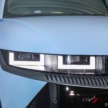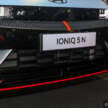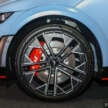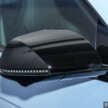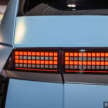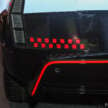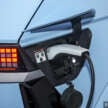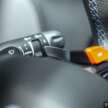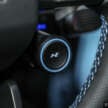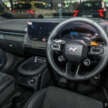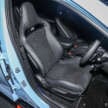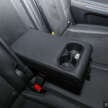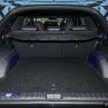Two years after the debut of the Ioniq 5 N, Hyundai has finally revealed the next chapter of its go-faster N division. You’re looking at the brand new Hyundai Ioniq 6 N, which takes the performance of the sleek electric sedan and dials it up to 11.
As expected, this car gets all the goodness of the Ioniq 5 N, not least its 226 PS (166 kW) front and 383 PS (282 kW) rear motors, together churning out 609 PS and 740 Nm of torque. And that’s not all – push the N Grin Boost (NGB) button on the steering wheel and those figures are boosted to 650 PS and 770 Nm.
The almost certainly lighter weight vis à vis the SUV allows the Ioniq 6 N to fling itself from zero to 100 km/h two tenths of a second quicker at 3.2 seconds, although bizarrely the top speed is slightly lower at 257 km/h. Next to its main rival, the Tesla Model 3 Performance, the car is a tenth of a second slower to the century mark and has a 4 km/h lower top speed.
A few changes have been made over the 5 N, mostly aimed at further improving track performance. For a start, the motors get upgraded magnets and a rotor cooling structure to reduce derating, and while the 84 kWh nickel manganese cobalt (NMC) battery has been left alone, the 6 N receives a new battery management called N Battery to keep temperatures at an optimum level.
This technology integrates the previously separate functions of N Race and N Battery Conditioning to enable peak power delivery to be higher for longer, while optimised thermal management and a higher-capacity battery coolant heater significantly reduce conditioning time. This has enabled the addition of a new third mode – Endurance – to join the usual Drag and Sprint (previously Track).
Other features have been carried over from the 5 N, including the N Drift Optimiser, which shifts power around and uses the stability control to aid sliding. The system gets new options for drivers to fine-tune the initiation and angle of the drift as well as the amount of wheel spin according to their skill level and driving style. There’s also N Torque Distribution that allows them to shunt the power fore and aft.
The 6 N also inherits the 5 N’s most novel features – N e-Shift and N Active Sound +, simulating gear changes and engine sounds respectively. Here, too, there are improvements: N e-Shift gets shorter “gear ratios” for quicker acceleration, but the bigger news is that this function now works with the rest of the car’s performance-enhancing features, such as launch control, N Drift Optimiser and N Torque Distribution. And yes, you can even play with the paddles while adaptive cruise control is on.
Further changes include the expanded shift lights that now include the head-up display and the ambient lighting, making for a more immersive experience. Meanwhile, N Active Sound + gains a new Lightspeed setting that makes a “futuristic sci-fi” noise, replacing the fighter jet-aping Supersonic. The Acoustic Design Processor (ADP) is also more powerful to enhance the sound quality, while louder external speakers mean that passers-by will be better able to hear your car, too.
A trick new feature is the N Track Manager, which allows drivers to analyse their on-track performance. They can create custom circuits and have the system then perform automatic lap timings, after which they can pore over their speed data, check how they performed across the lap and even watch a ghost car replay, Gran Turismo style.
All this will be for nought if the handling doesn’t stack up, which is why the 6 N has been substantially redeveloped over the regular Ioniq 6. Benefitting from that car’s lower profile versus the Ioniq 5, the 6 N gets fully redesigned suspension geometry that shifts the hard points to further lower the centre of gravity.
On-centre steering feel has also improved thanks to an increased caster angle, which has the added effect of increasing feedback, self-centring and high-speed stability. There are also new bushings and stroke-sensing adaptive dampers that have a wider range of damping force adjustment. These changes have been accompanied by a stiffened chassis that includes a rear bulkhead cross bars, a more rigid underfloor cover and additional bracing on the suspension mounts and rear floor and quarter panels.
Going hand-in-hand with the increased performance, the design has been made much more aggressive, drawing inspiration from the RN22e that preceded the 5 N. The 6 N uses the facelifted Ioniq 6 as the base, meaning it gets the same split headlights (with slim daytime running lights up top) and spoiler-less boot lid with four-a-side illuminated red dots, the latter replacing the pre-facelift’s full-width taillight bar.
On top of this, Hyundai has added new bumpers with larger air intakes at the front and twin grey “tusks” that wrap around to form the bumper corners. The skirting all around the car gets N’s signature red striping, and there’s also a swan-neck rear wing that again improves high-speed stability.
As per the Ioniq 5 N, the 6 N gets flared wheel arches, but this time they’re integrated into the fenders for a sleeker, cleaner look. They house fatter 20-inch five-spoke aero forged wheels wrapped in bespoke Pirelli P Zero tyres, hiding larger brakes that are assisted by up to 0.6 g of regenerative braking, as per the 5 N.
What’s new is that the car can regen brake up to 0.35 g even when ABS is activated, helping to keep the friction brakes from fading on track. A returning N Pedal uses up to 0.3 g of regen braking to shift the car’s weight to the front tyres upon lifting off – akin to trail braking – for tighter turn-in.
The exterior addenda over the Ioniq 6 means the N version isn’t nearly as aerodynamic, with the drag coefficient ballooning from 0.21 to 0.27. Still, that’s a damn sight better than the 5 N’s 0.313, which should usefully improve range (no official figures have been released as yet). Lastly, the signature Performance Blue paint option gains a pearl effect for a deeper appearance.
Inside, the 6 N again receives the usability improvements from the facelifted Ioniq 6, most notably the new centre console with twin USB-C ports and a more compact and fully-featured physical control panel that frees up space for more storage.
N-specific items include a round three-spoke steering wheel with twin customisable N buttons, bucket seats with illuminated N logos and Performance Blue accents on the air vents and seat belts. There’s even a built-in mount in the roof that allows you to attach an action camera.
The Hyundai brand as a whole is gaining interest in Malaysia thanks to the establishment of the new Hyundai Motor Malaysia (HMY) principal company, taking over from Hyundai-Sime Darby Motors (HSDM). Don’t hold your breath for the Ioniq 6 N (or indeed, the entire facelifted Ioniq 6 range) to arrive here, however, as EVs do not figure in the firm’s plans as yet.
















































